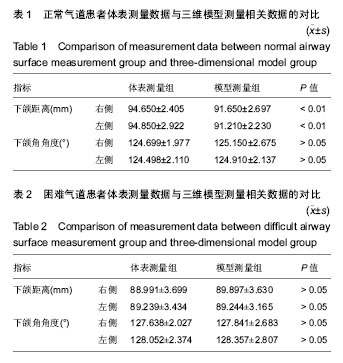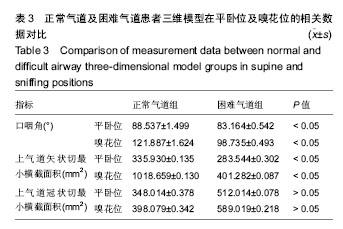中国组织工程研究 ›› 2019, Vol. 23 ›› Issue (4): 562-566.doi: 10.3969/j.issn.2095-4344.1037
• 数字化骨科 digital orthopedics • 上一篇 下一篇
困难气道患者三维有限元模型解剖差异的分析
谢雨晨,陈文栋,马 莉
- 昆明医科大学第一附属医院麻醉科,云南省昆明市 650032
Anatomical differences in three-dimensional finite element model of difficult airway patients
Xie Yuchen, Chen Wendong, Ma Li
- Department of Anesthesiology, First Affiliated Hospital of Kunming Medical University, Kunming 650032, Yunnan Province, China
摘要:
文章快速阅读:
.jpg)
文题释义:
三维实体建模:是一种集计算机辅助绘图与参数化实体造型、装配造型、二维和三维双向关联绘图及图形转换器等模块为一体的现代机械设计手段。实验运用Mimics软件对正常人体上气道创建三维实体模型,并通过mimics软件自带测量工具进行数据测量,分析该模型在临床工作中的实用性,可为临床工作提供数据分析,指导临床工作。
困难气道:是指可能对麻醉后维护气道通畅及气管插管造成困难的各种临床情况,包括面罩给氧困难和气管内插管困难。研究通过对正常气道及困难气道三维模型进行数据测量,对其在平卧位及嗅花位变化时口咽及上气道的数值变化进行解剖分析,对临床工作具有重要意义。
摘要
背景:近年来随着科学技术的发展,三维模型越来越多的运用到医学领域中。气道管理是麻醉手术中最重要环节之一,而在国内外较少见有关人体气道三维有限元模型的研究。
目的:应用MRI检查获得的二维断层图像重建人体气道三维有限元模型,分析困难气道三维模型的解剖差异。
方法:纳入手术麻醉过程中确定为正常气道和困难气道患者各20例,获取其头颈部核磁共振二维图像数据,应用Mimics10.01软件重建包括整个下颌骨、舌骨及上气道等在内的三维实体数字化模型,利用Mimics自带测量软件测量相关指标,同时对正常人体体表标志进行测量并获得相关数据,与模型所测指标行配对比较,分析困难气道患者与正常气道患者的解剖差异。
结果与结论:①正常气道患者下颌距离的三维模型组测量值较正常人体体表测量组偏小(P < 0.01);困难气道患者下颌距离的三维模型组测量值较正常人体体表测量组偏大,但差异无统计学意义(P > 0.05);正常气道、困难气道患者下颌角角度的三维模型组测量值较正常人体体表测量组偏大,但差异无统计学意义(P > 0.05);②在平卧位及嗅花位时,正常气道组口咽角角度、矢状切最小横截面积均大于与困难气道组(P < 0.05),两组冠状切最小横截面积比较差异无显著性意义(P > 0.05);③结果表明,运用 MRI人体气道数据可建立较为真实可靠的三维有限元模型,利用三维有限元模型可有效分析困难气道患者的解剖差异,为以后临床上工作中预测困难气道提供参考。
中国组织工程研究杂志出版内容重点:人工关节;骨植入物;脊柱;骨折;内固定;数字化骨科;组织工程
ORCID: 0000-0002-4521-4825(谢雨晨)
中图分类号:


.jpg)
.jpg)